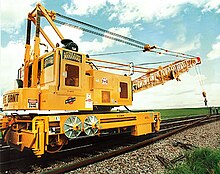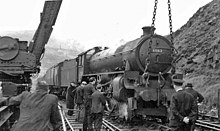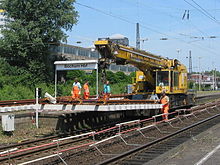
A train is a series of connected vehicles that run along a railway track and transport people or freight. Trains are typically pulled or pushed by locomotives or railcars, though some are self-propelled, such as multiple units. Passengers and cargo are carried in railroad cars, also known as wagons. Trains are designed to a certain gauge, or distance between rails. Most trains operate on steel tracks with steel wheels, the low friction of which makes them more efficient than other forms of transport.

A crane is a machine used to move materials both vertically and horizontally, utilizing a system of a boom, hoist, wire ropes or chains, and sheaves for lifting and relocating heavy objects within the swing of its boom. The device uses one or more simple machines, such as the lever and pulley, to create mechanical advantage to do its work. Cranes are commonly employed in transportation for the loading and unloading of freight, in construction for the movement of materials, and in manufacturing for the assembling of heavy equipment.

A switcher locomotive, shunter locomotive, or shifter locomotive is a locomotive used for maneuvering railway vehicles over short distances. Switchers do not usually move trains over long distances, instead they typically assemble trains in order for another locomotive to take over. Switchers often operate in a railyard or make short transfer runs. They may serve as the primary motive power on short branch lines or switching and terminal railroads.

Under the Whyte notation for the classification of steam locomotives, 0-4-0 represents one of the simplest possible types, that with two axles and four coupled wheels, all of which are driven. The wheels on the earliest four-coupled locomotives were connected by a single gear wheel, but from 1825 the wheels were usually connected with coupling rods to form a single driven set.

A tow truck is a truck used to move disabled, improperly parked, impounded, or otherwise indisposed motor vehicles. This may involve recovering a vehicle damaged in an accident, returning one to a drivable surface in a mishap or inclement weather, or towing or transporting one via flatbed to a repair shop or other location.

A steam shovel is a large steam-powered excavating machine designed for lifting and moving material such as rock and soil. It is the earliest type of power shovel or excavator. Steam shovels played a major role in public works in the 19th and early 20th century, being key to the construction of railroads and the Panama Canal. The development of simpler, cheaper diesel, gasoline and electric shovels caused steam shovels to fall out of favor in the 1930s.

The Western Pacific Railroad Museum (WPRM) in Portola, California, known as the Portola Railroad Museum until January 1, 2006, is a heritage railroad that preserves and operates historic American railroad equipment and preserves documents, photos and information. The museum's mission is to preserve the history of the Western Pacific Railroad and is operated by the Feather River Rail Society, founded in 1983. It is located at a former Western Pacific locomotive facility, adjacent to the Union Pacific's former Western Pacific mainline through the Feather River Canyon.
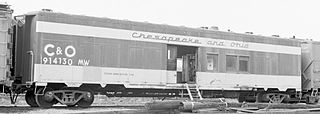
A steam generator is a type of boiler used to produce steam for climate control and potable water heating in railroad passenger cars. The output of a railroad steam generator is low pressure, saturated steam that is passed through a system of pipes and conduits throughout the length of the train.

The 620/720 class railcars were a class of diesel multiple unit built by the New South Wales Government Railways and operated from 1961 until 2007.

The 45 class are a class of diesel-electric locomotives built by AE Goodwin, Auburn for the New South Wales Department of Railways between 1962 and 1964.

The Fort Eustis Military Railroad is an intra-plant United States Army rail transportation system existing entirely within the post boundaries of the United States Army Transportation Center and Fort Eustis (USATCFE), Fort Eustis, Virginia. It has served to provide railroad operation and maintenance training to the US Army and to carry out selected material movement missions both within the post and in interchange with the US national railroad system via a junction at Lee Hall, Virginia. It consists of 31 miles (50 km) of track broken into three subdivisions with numerous sidings, spurs, stations and facilities.

The National Rail Museum in Chanakyapuri, New Delhi, displays exhibits on the history of rail transport in India. The museum was inaugurated on 1 February 1977. The museum spans over an area of over 11 acres and the indoor gallery comprises an octagonal building which houses six display galleries and a large open area is laid out to simulate the atmosphere of a railway yard. It is open every day except Mondays and national holidays.

The New South Wales 42 class was a class of diesel locomotives built by Clyde Engineering, Granville for the New South Wales Department of Railways in 1955/56.

A steam crane is a crane powered by a steam engine. It may be fixed or mobile and, if mobile, it may run on rail tracks, caterpillar tracks, road wheels, or be mounted on a barge. It usually has a vertical boiler placed at the back so that the weight of the boiler counterbalances the weight of the jib and load.

The X200 class were a class of rail tractors introduced in 1963 and operated by the New South Wales Government Railways of Australia. They were a development of the smaller and less numerous X100 class. The X200 class remained in service until 1990 when they were either withdrawn or sold off to private companies, and some remain operational today.
Joseph Booth & Bros was an English company notable for making cranes used in large construction projects.

The Junee Roundhouse Railway Museum preserves the former Junee Locomotive Depot, a railway depot located on the Main Southern line in Junee, Australia.

The X10 class is a class of steam locomotives previously operated by the New South Wales Government Railways of Australia.
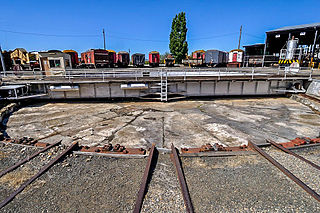
The Goulburn Rail Heritage Centre is located at the heritage-listed former railway workshops in Goulburn, New South Wales, Australia, on the Main Southern railway line. Now a museum, it is also known as the Goulburn Rail Workshop and Goulburn Roundhouse. The workshops were added to the New South Wales State Heritage Register on 2 April 1999. The workshops were saved from demolition by the Goulburn Locomotive Roundhouse Preservation Society and is now a museum open to the public with large collection of rolling stock and various exhibits, as well as privately owned locomotives and carriages with some commercial repair work happening on site.
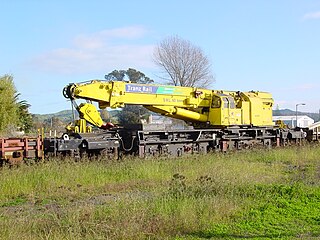
Various rail operators in New Zealand have used rail cranes, for various tasks on maintaining the rail corridor, including accident recovery work. Typically there are two classes, EL indicating diesel, and ELS indicating steam operation.
